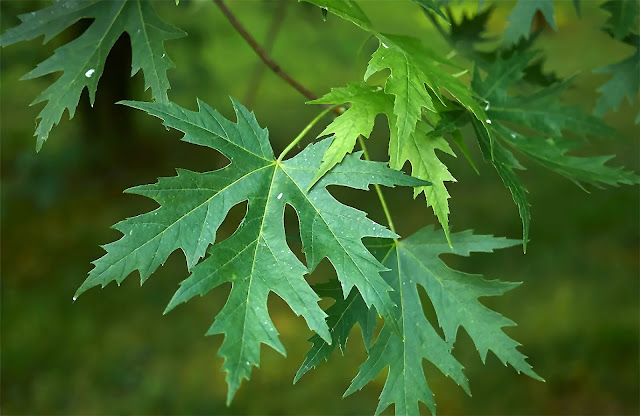Today's post will be about the Silver Maple tree. The Latin name for this species is Acer saccharinum. Unfortunately, this tree can also be referred to by a lot of other names, including creek maple, water maple, soft maple, white maple, and silverleaf maple. We like to stick to just silver maple. Unfortunately, the Latin name for silver maple is very close to the Latin name for sugar maple (Acer saccharum), which can be very confusing for budding botantists (pardon the pun).
Here's a photo of a very large silver maple in Lincoln Park, Nebraska. No, not Linkin Park.
You can see that this tree doesn't necessarily need to grow beside creeks or water. There's a large silver maple in Mactaquac provincial park that I should have taken a photo of. There are actually a lot of silver maples in Mactaquac, but I'm thinking of one in particular by the new skating trails.
Within Canada, the range of the silver maple has a moderate overlap with the range of red maple, although red maple grows both further north and further south. Here's a map for silver maple, courtesy of Wikipedia. You'll notice that it doesn't extend too far into the Maritimes, but that's changing as the climate warms. Residents of southern Ontario are quite familiar with this tree though.
Perhaps the most unique thing about the silver maple, in my eyes, is how deep the notches are between the lobes on the leaves (especially the two notches on either side of the central notch). The leaves are very visually distinct from other maples.
The seeds of the silver maple come in paired samaras, like other maple trees. However, quite commonly, only one seed of the pair will develop fully. The shape of the seeds is also slightly different than some other types of maple. Here's a beautiful photo, which came from a very nice blog post by the Michigan Nature Guy, which you should check out. Lots of good info there!
Here are a few Fun Facts about silver maples:
1. Silver maples are one of the first trees to wake up in the spring. They are also important for bees, because they are one of the first trees to produce pollen in the spring.
2. Silver maples can be "variably dioecious," which means that the trees can be male or female, or they can also be monoecious, which means that a single tree has both male and female flowers.
3. Silver maple is a very fast-growing tree, often adding two feet per year. But if you're planting it near your house, we recommend that you be careful. It has a very large strong root system that might seek water and compromise your foundation. Try to keep it at least 15-20 meters away from your house.
Silver maple is a fun tree to plant, when seedlings are available. We've included silver maples on several of our projects. It's a great species for restoration projects, especially when moist soils are available.
Thanks for reading!
Replant.ca Environmental is a Canadian company that plants trees for carbon capture and builds community forests. We also plant trees in national, provincial, and municipal public parks to mitigate damage from wildfires, storms, insects, and forest diseases. We operate thanks to numerous small contributions from the general public, in addition to larger project sponsorships from businesses and corporations around the world. If you'd like to learn how to show your support, visit our donations page. Even if you aren't able to make a contribution, we very much appreciate when people are able to share our posts or our website link on social media, to help spread the word about the work that we're doing!
Teachers are welcome to use content from this post for their classes. If you know a teacher who might like to use this information, please share it with them! The more that people learn about trees, the better our world will be.
To learn more about the various species that we plant, visit the conifers page or the deciduous (hardwoods) page on our website. Thanks so much for your interest!
Incidentally, our organization is often seeking additional land for our carbon capture projects. Please visit this link if you might know of a recently-harvested property that we could rebuild into a permanent legacy forest.





No comments:
Post a Comment